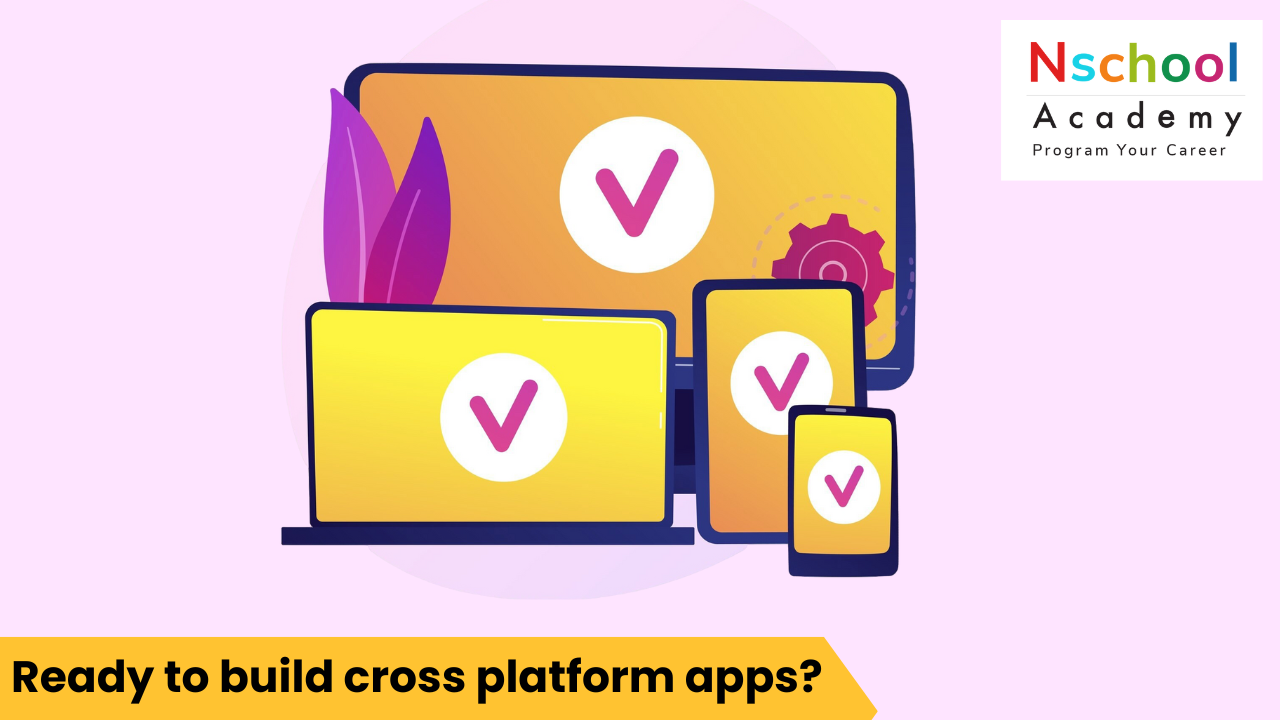Ready to build cross platform apps
- December 7, 2024
- nschool
- 0

Introduction
In this blog post, we will be focusing on what cross platform app development covers, its pros and cons, the kind of frameworks available in the market for creating cross-platform apps, and some of the hurdles developers are likely to encounter while developing cross-platform apps.
In the world of mobile and web development, companies and individuals are experiencing issues with reaching their audiences through different platforms. Smartphones, tablets, desktops, and the web all have their own development requirements. In the earlier days of development, developers had to design and develop applications and software for each platform, which cost more money, time, and complications when it came to maintenance. But there is a better approach, which is called cross-platform app development.
Mobile application development, where an application is built with a single code base to work on both operating systems, offers a programmer the benefit of a shorter and cheaper development time. If you picture yourself building an app but do not wish to face the challenges of a platform-specific approach, cross-platform development can be exactly what you need.
Cross-Platform App Development
Cross-platform app development means developing applications that will run on more than one OS or environment utilizing a single code base. Due to this, it is possible for developers to write a single code, and when deploying it on different platforms, they do not have to rewrite a lot of code.
It also allows marketing professionals to solve their key challenge of reaching people without investing a lot of resources in the development of particular platforms. Rather than investing time in the process of creating native apps for iOS and Android, cross-platform development allows a developer to write and provide a single, cohesive application that can be run across all these platforms.
Why Should You Consider Cross-Platform Development?
Cost-Efficiency
Another benefit related to the process of cross-platform development is the possible increase in effective costs. The worst is when you create a new application for each platform, which might be more resource-demanding as one has to hire different developers for iOS and Android. The same development team working on one OS can work on an application for another, this alleviates the problem of having to hire developers, testers, and project managers for each platform. The thing is that since you are writing only one codebase, the total cost of development is lower.
Faster Time to Market
Build once, deploying anywhere shortens the time required before you can introduce your application on the market. One codebase to write for multiple platforms reduces the amount of work to be written since you are writing one code for all the platforms. Also, a lot of cross-platform tools have features such as hot swapping and a host of built-in components thereby accelerating the development phase. The single change capability means modifications are made only once, making updates and new features apply all at once, thus making your users happy and your development timetable right on course.
Consistent User Experience
It is quite complicated to maintain a consistent UX when developing different applications for each type of platform that is out there. Another drawback is that both platforms employ their design guidelines, so an application can appear well in Android but not in iOS, and back. Frameworks that span across platforms work towards delivering an intentional experience across multiple platforms. They enable the developers to work with reusable UI elements and bring design patterns that make the app have the same interface design across the devices. This allows for nice continuity between devices such as smartphones, tablets, or a desktop at home or in the office as a laptop.
Ease of maintenance and gradation
Having and working with several codebases is not always efficient and could lead to a situation where they get out of hand. This effectively means that the app developed for both platforms uses a single code set; this simplicity affords easy correction for bugs or the addition of new enhancements as well as updating of the application throughout the two platforms. All this and more makes the software development life cycle seamless, while every modification to the shared code is instant on all platforms, whether it is a security patch, an attempt to boost performance, or a simple change in the user interface of the application.
Wider Audience Reach
This tool enables you to reach more people the moment you develop for different platforms without having different applications for each one. This means you can reach out to Android, iOS, and even browsers with the same code you are writing, right now. That in turn greatly expands the reach of your user base and guarantees that your application can be used on a variety of devices.
Popular Cross-Platform Frameworks for Mobile and Web Apps
With an understanding of why cross-platform development should be a part of your plan, let me proceed to the list of tools – the most popular among developers. These frameworks create an opportunity to use one code base to build an application that can be used on iOS, Android, websites, and on some laptops and PCs.
Flutter Platform
- Platform Support : iOS, Android, Web, Desktop
- Language: Dart
- Why Choose Flutter? Today, many companies create cross-platform, but Flutter is one of the most popular now, created by Google. It enables application developers to build applications that are, performance-wise, gorgeous, from one code base.
The factor that stands Flutter out is that it can build applications that look and perform like a native application, this is because Flutter compiles to native ARM code. Flutter also has several well-thought widgets and tools for customization which makes it easier to design fine user interfaces. To my mind, one of the biggest advantages and characteristics of Flutter is flexibility and work speed. First, using the framework is accompanied by a hot-reload feature to present the changes introduced to the code without rerunning the entire application. As we have already mentioned, this feature is crucial during development as it shortens the time to get through the cycles. Flutter is specifically designed to support mobile platforms such as iOS and Android but also web and desktop applications. Therefore, it is suitable if your target is to create an application for multiple platforms in the future.
React Native
- Platform Support: iOS, Android H
- Language: JavaScript
- Why Choose React Native? Another popular cross-platform framework is React Native by Facebook similar to Xamarin based on the popular framework JavaScript and the React framework.
React Native is quite easy to learn for anyone who has prior knowledge of the React framework since, like RN, React also follows the component-based architecture. First and arguably the most significant strength of React Native is the rich library, tools, and open-source community. It also has something called “native modules,” which let the developer write platform-specific code when desired, and it isn’t restricted in any way.
Xamarin
- Platform Support: iOS, Android, Windows
- Language: C#
- Why Choose Xamarin? Xamarin is a development platform for building mobile applications, backed by Microsoft which enables developers to use C# and .NET for this purpose.
With Xamarin, the developer can write the app for iOS, Android, or Windows and can also use the specific APIs of each, whenever it is necessary. It compiles down to native code, and therefore, ensures that all apps created with the aid of this framework exhibit high performance. It also has plentiful libraries and tools and is recommended for the use of big enterprises and other applications that are developed in .NET. Xamarin is a great fit for those who are extensively working in a Microsoft environment or for those who are already familiar with C# language.
Ionic
- Platform Support: iOS, Android, Web
- Language: JavaScript, TypeScript with Angular/React / Vue
- Why Choose Ionic? Ionic is a hybrid framework that is helpful for developers who want to build apps using web technologies such as HTML, CSS & JavaScript.
It contains a set of ready controls and native APIs to implement necessary apps with the look and feel of traditional ones despite the Hybrid implementation. Ionic is based on Angular, however, it is compatible with both React and Vue.js, which expands the possibilities developers are used to working with. Ionic is great for developers who already know web development and perfect if you want to create progressive web apps and hybrid mobile apps. Ionic is a powerful solution if you need to deploy your app not only to the Internet but also to different mobile platforms. Android or iOS can be targeted with equal repeatability as can the web relying on a single codebase.
Key Challenges of Cross-Platform Development
While cross-platform development comes with numerous advantages, it also presents some challenges that developers must consider.
Platform-Specific Features
The CQDSS architecture adopted and implemented on each platform is that each platform has its set of features and APIs that are specific to the platform. For instance, while developing applications for iOS and Android platforms, developers are to operate with different user interface standards and conventions. Frameworks like Flutter and React Native currently provide solutions to almost all cross-platform development challenges, but sometimes these may necessitate the use of native code. For example, if your app requires it to access device capabilities such as a camera, notifications, or biometric identification, you will find yourself having to code this in a platform-specific way or leveraging third-party tools or libraries.
Performance Issues
Cross-platform frameworks have advanced dramatically in their operations, but they still can be slower than the native apps in some cases, for example, in the usage of complicated animations, and graphics, or performing computationally demanding operations. UGA, which includes apps that heavily rely on performance (e.g. games, or applications that work with real-time data) may not offer the smoothness of native applications.
Limited Access to Native APIs
Cross-platform frameworks afford developers the capability of accessing almost all native APIs and what might remain would be very limited platform-specific functions that may force a developer to write the code in the platform he is developing in. This may include additional modules for iOS or Android whenever an individual feature is not provided by the framework classes.
Debugging and Testing
If an application is designed for multiple platforms then it has to work and run smoothly on each of the target platforms. Due to browser compatibility across devices and operating systems and screen resolutions, testing can be a little more complex compared to developing for one platform.
Conclusion
The development of applications that work across multiple platforms, mobile and web, is state of the art. Other frameworks that can be used in building versatile mobile applications include Flutter, react natives, Xamarin, or Ionic as they will help developers build apps that can run faster, smoother, and more efficiently using fewer resources and time than developing the apps from scratch.
Besides the advantages of cross-platform development which have been discussed above, one should remember about disadvantages which are the problems that may occur while developing or using applications, for example, restricted usage of some abilities of operating systems. Knowing your way around the different frameworks will help you to understand their strengths and limitations and then decide which is appropriate for your project.
If you are ready to start on your next application, the cross-platform might just be the solution that offers the type of versatility, speed, and growth that today’s mobile and web-centered economy requires. Select the right framework, use your current knowledge and rolé right away, and start creating great applications! This II version offers more in-depth information on cross-platform app development, the advantages, disadvantages, and frameworks, but at the same time makes this information more comprehensible and easy to understand.

